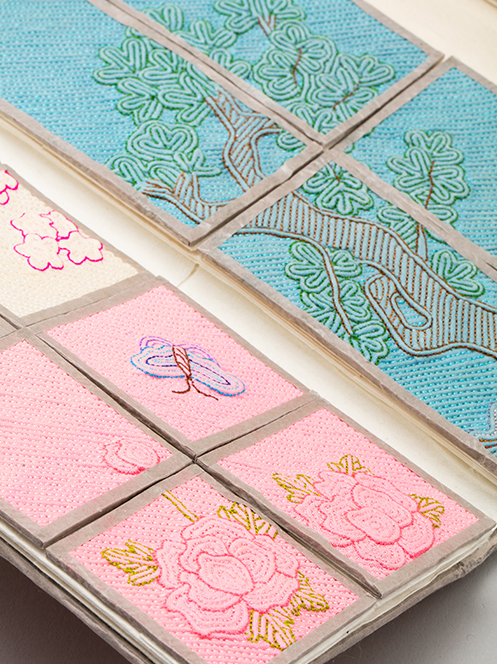
Contents










Crafts · Written by Lee Eun-yi, designer & writer
Photo courtesy of National Intangible Cultural Heritage Association, Lee Deoug Eun
Handicraft Haute Couture
Saeksilmunyang-nubi
What was the hottest handcraft design in Korea last year?
The Korea Annual Traditional Handcraft Art Exhibition,
which recognizes and selects outstanding handicrafts, granted Lee Deok-eun the
prestigious President’s Award for her saeksil-nubi saeksil-cheop (color quilted sewing pouch),
21 years after master artisan Kim Yoon-seon showed her creations at the same event.
Once a glossed over item, saeksilmunyang-nubi has become one of the top-rated handicrafts in Korea.

While nubi (quilting) is fairly well-known, saeksilmunyang-nubi is an unfamiliar concept. To protect from the cold, nubi is the practice of putting cotton between cloth and sewing along patterns to ensure that the cotton is evenly spread. There are many patterns, and this technique is usually used to make clothes or comforters. Saeksilmunyang-nubi, on the other hand, prioritizes durability and design over function, using hanji (traditional Korean paper) instead of cotton. Between two layers of cloth along the lining of the patterns, a long twisted-shaped hanji is inserted and stitched on both sides with colorful threads.
Gaps between seams should be within 2 mm and between stitches within 1.5 mm. A densely stitched saeksilmunyang-nubi is moisture-resistant and sturdy, perfect for use as a pouch to store cigarettes, flint, needles, glasses or paper vulnerable to humidity. Its origin is traced back to the Joseon Dynasty era (1392-1910), when women put together leftover fibers such as silk, cotton or hemp cloth with other silk and cotton threads. This practical yet elegant design has survived to the present day and earned the title of “best handicraft design.”
 Subtle stitches and beautiful colors are well blended and show outstanding look.
Subtle stitches and beautiful colors are well blended and show outstanding look. This saeksil-nubi saeksil-cheop (color quilted sewing pouch) won the President’s Award at the 2018 Korea Annual Traditional Handcraft Art Exhibition.
This saeksil-nubi saeksil-cheop (color quilted sewing pouch) won the President’s Award at the 2018 Korea Annual Traditional Handcraft Art Exhibition.Timeless Value of Handicraft
Hanji that goes between cloth makes saeksilmunyang-nubi look fluffy, and colorful threads decorate every side of the design, giving it a gorgeous and harmonious look. Every pattern represents a message: a long stretched thread means long life, farm hills represent abundance, butterflies hope and peony wealth. A collaborative work for the PyeongChang 2018 Winter Olympics’ poster by Hwang Su-hong and Hong Hyun-jeong was also inspired by the aesthetics of this quilted pouch, earning the Art Poster Prize from the International Olympic Committee.
More than 20 years have passed since saeksilmunyang-nubi was recognized as a handicraft. When Yu Hee-kyung, president of the Costume Culture Research Institute, saw a work by saeksilmunyang-nubi master Kim Yoon-seon in 1988 at her private exhibition, this prompted Yu to separate saeksilmunyang-nubi from nubi in the craft category. Kim was inspired by her great grandmother’s handmade cigarette pouch to revive this cultural art. More recently, artisans have expanded saeksilmunyang-nubi’s style to make fashion items such as brooches and clutch bags, being careful to preserve the traditional design of this handicraft while catering to modern demands. Though small and simple as a pouch, the craft is imbued with the artistic flair and wisdom of Korea’s ancestors.
Other Articles






Hanbok Designer Extraordinaire



Bridging Korean and Vietnamese Culture






